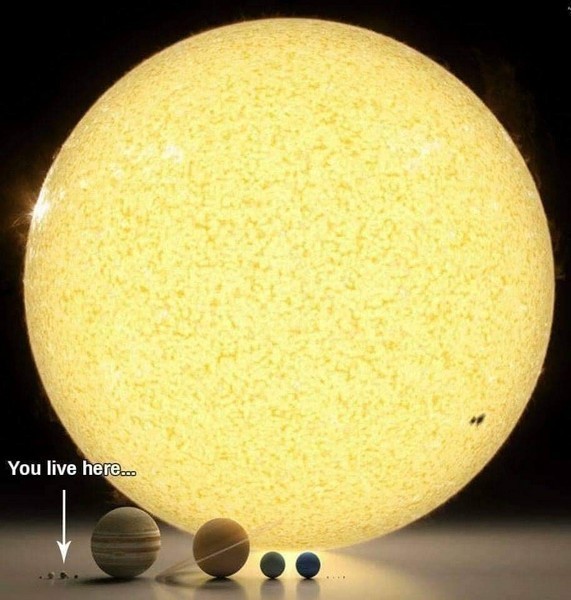
Hubble Pictures of The Universe

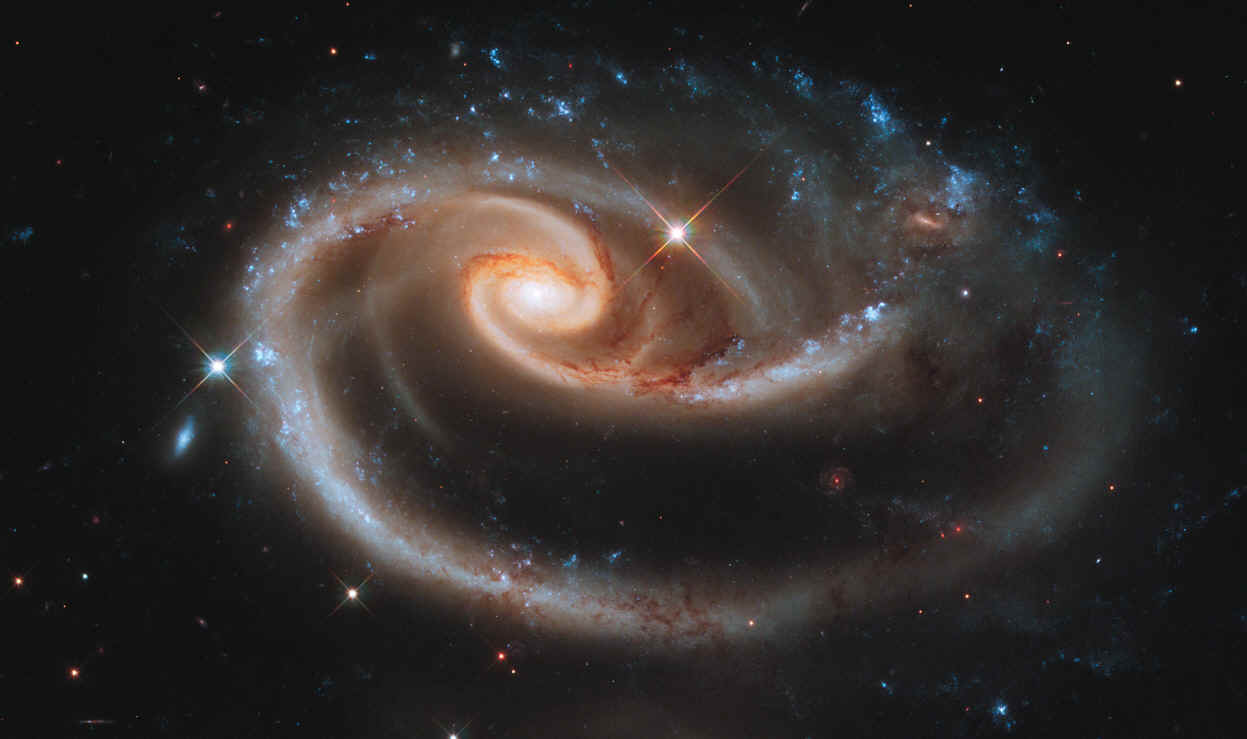
1. A "Rose" of a Galaxy. In celebration of the 21st anniversary of the
Hubble Space Telescope's deployment into space, astronomers at the Space Telescope Science
Institute pointed Hubble's eye to an especially photogenic group of interacting galaxies
called Arp 273. Pictured here is the larger of the two galaxies, known as UGC 1810. It has
a disk that is tidally distorted into a rose-like shape by the gravitational tidal pull of
the companion galaxy below it, known as UGC 1813. A swath of blue jewels across the top is
the combined light from clusters of intensely bright and hot young blue stars. These
massive stars glow fiercely in ultraviolet light. A possible mini-spiral may be visible in
the spiral arms of UGC 1810 to the upper right. It is noticeable how the outermost spiral
arm changes character as it passes this third galaxy, from smooth with lots of old stars
(reddish in color) on one side to clumpy and extremely blue on the other. UGC 1810 lies in
the constellation Andromeda and is roughly 300 million light-years away from Earth. More
info here.
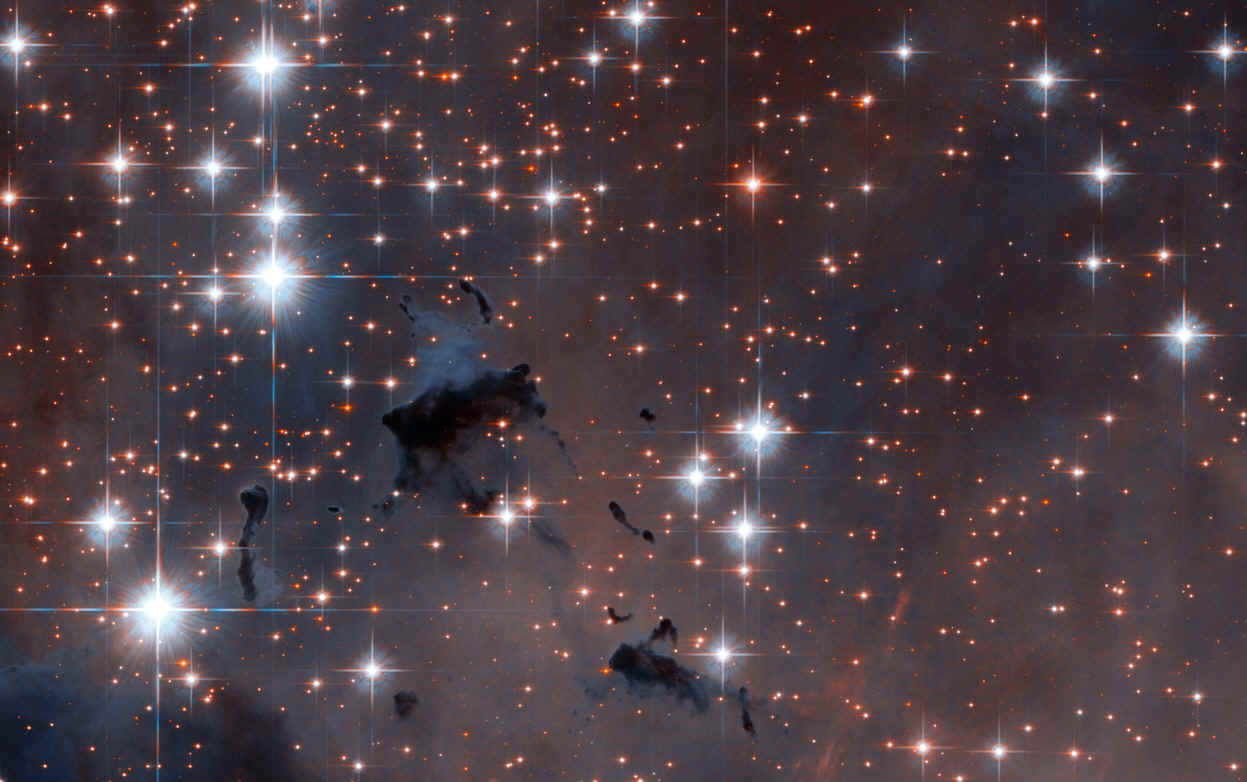
2. This collection of dazzling stars is called NGC 6611, an open star cluster
that formed about 5.5 million years ago and is found approximately 6500 light-years from
the Earth. It is a very young cluster, containing many hot, blue stars, whose fierce
ultraviolet glow make the surrounding Eagle Nebula glow brightly. The cluster and the
associated nebula together are also known as Messier 16. Astronomers refer to areas like
the Eagle Nebula as HII regions. Extrapolating far into the future, this HII region will
eventually disperse, helped along by shockwaves from supernova explosions as the more
massive young stars end their brief but brilliant lives. In this image, dark patches can
also be spotted, punctuating the stellar landscape. These areas of apparent nothingness
are actually very dense regions of gas and dust, which obstruct light from passing
through. Many of these may be hiding the sites of the early stages of star formation,
before the fledgling stars clear away their surroundings and burst into view. More info here
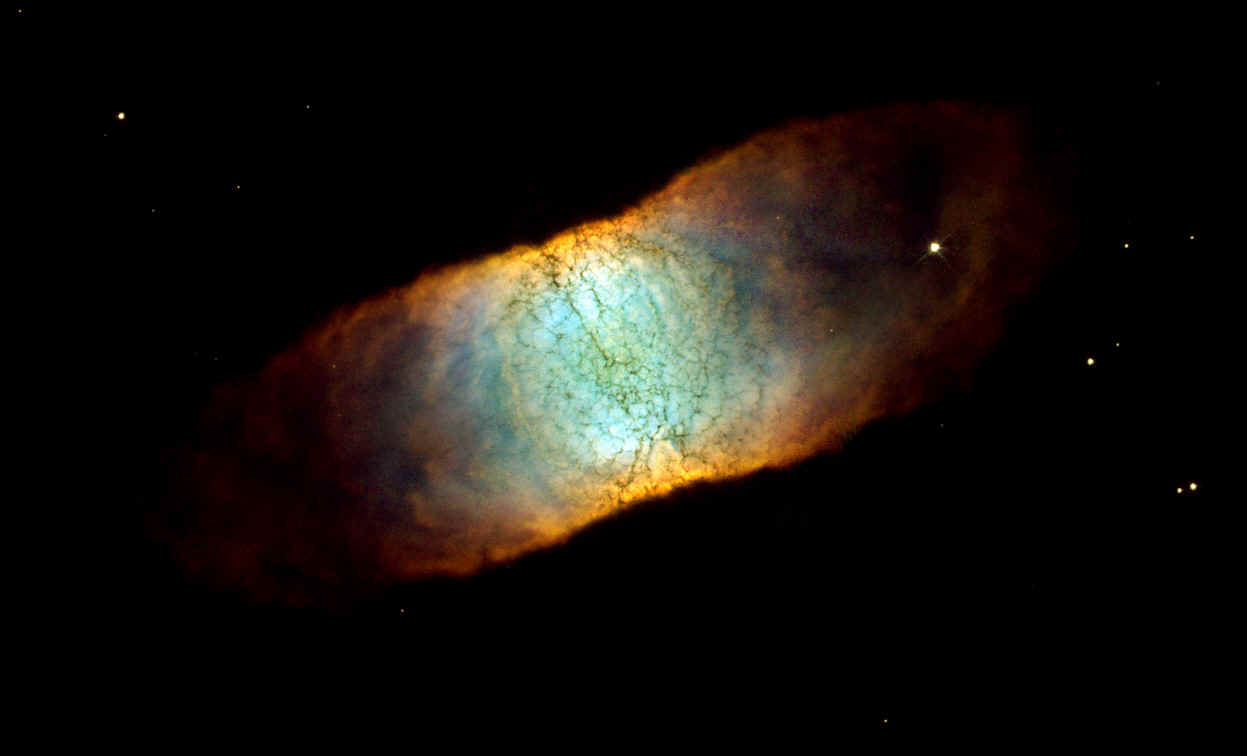
3. A dying star, IC 4406, dubbed the "Retina Nebula" exhibits a high degree of symmetry; the left and right halves of the Hubble image are nearly mirror images of the other. If we could fly around IC 4406 in a starship, we would see that the gas and dust form a vast donut of material streaming outward from the dying star. From Earth, we are viewing the donut from the side. This side view allows us to see the intricate tendrils of dust that have been compared to the eye's retina. In other planetary nebulae, like the Ring Nebula (NGC 6720), we view the donut from the top. The donut of material confines the intense radiation coming from the remnant of the dying star. Gas on the inside of the donut is ionized by light from the central star and glows. Light from oxygen atoms is rendered blue in this image; hydrogen is shown as green, and nitrogen as red. The range of color in the final image shows the differences in concentration of these three gases in the nebula. Unseen in the Hubble image is a larger zone of neutral gas that is not emitting visible light, but which can be seen by radio telescopes. One of the most interesting features of IC 4406 is the irregular lattice of dark lanes that criss-cross the center of the nebula. These lanes are about 160 astronomical units wide (1 astronomical unit is the distance between the Earth and Sun). They are located right at the boundary between the hot glowing gas that produces the visual light imaged here and the neutral gas seen with radio telescopes. We see the lanes in silhouette because they have a density of dust and gas that is a thousand times higher than the rest of the nebula. The dust lanes are like a rather open mesh veil that has been wrapped around the bright donut. The fate of these dense knots of material is unknown. Will they survive the nebula's expansion and become dark denizens of the space between the stars or simply dissipate? More info here.
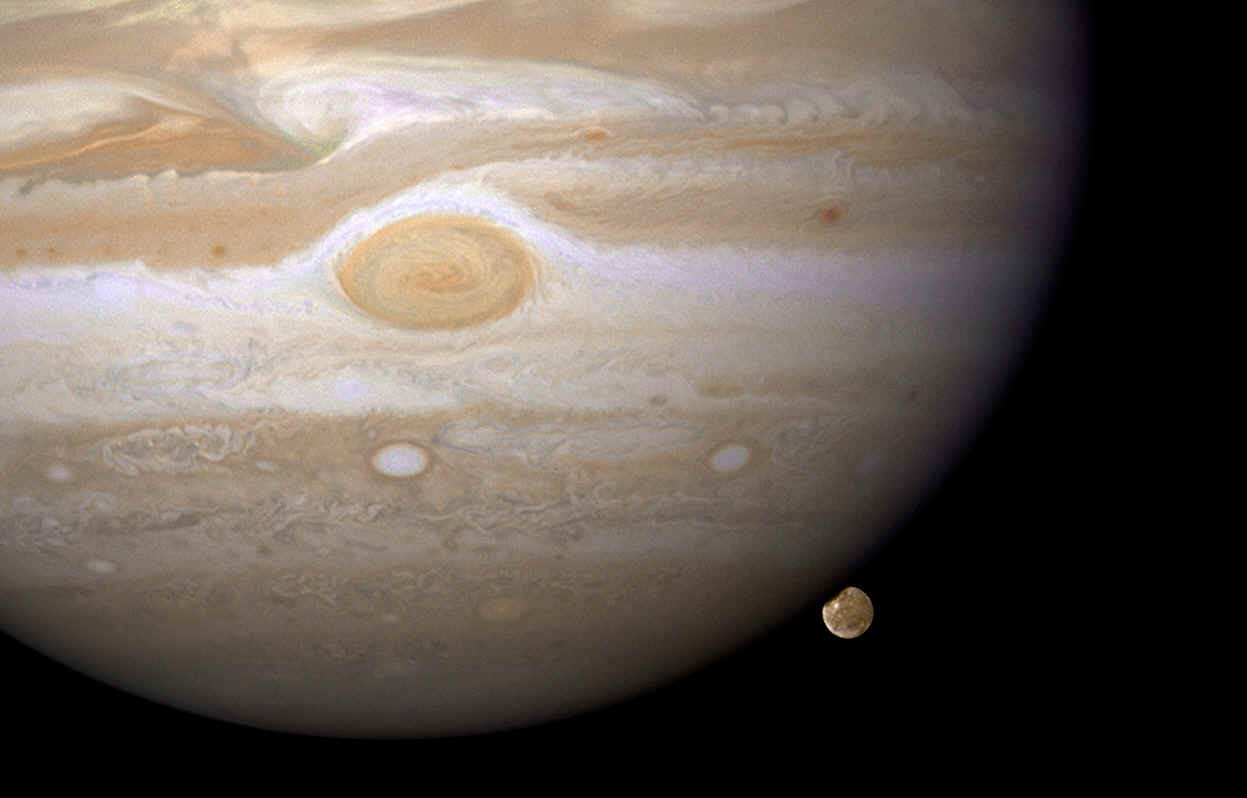
4. Hubble catches Jupiter's moon Ganymede just before it ducks behind the giant planet. Ganymede completes an orbit around Jupiter every seven days. Because Ganymede's orbit is tilted nearly edge-on to Earth, it routinely can be seen passing in front of and disappearing behind its giant host, only to reemerge later. Composed of rock and ice, Ganymede is the largest moon in our solar system. It is even larger than the planet Mercury. But Ganymede looks like a dirty snowball next to Jupiter, the largest planet in our solar system. Jupiter is so big that only part of its Southern Hemisphere can be seen in this image. Even though Jupiter is some 730 million kilometers (450 million miles) distant in this image, Hubble's view is so sharp that astronomers can see features on Ganymede's surface, most notably the white impact crater, Tros, and its system of rays, bright streaks of material blasted from the crater. Tros and its ray system are roughly the width of Arizona. The image also shows Jupiter's Great Red Spot, the large eye-shaped feature at upper left. A storm the size of two Earths, the Great Red Spot has been raging for more than 300 years. As Ganymede passes behind the giant planet, it reflects sunlight, which then passes through Jupiter's atmosphere. Imprinted on that light is information about the gas giant's atmosphere, which yields clues about the properties of Jupiter's high-altitude haze above the cloud tops. More info here

5. The view of the Hubble Advanced Camera for Surveys is filled by stars, part of NGC 6791, an old open star cluster in the Lyra constellation. The bright stars are roughly 13,300 light years distant. Two background galaxies, far beyond our own Milky Way, can be seen at upper left. More info here.
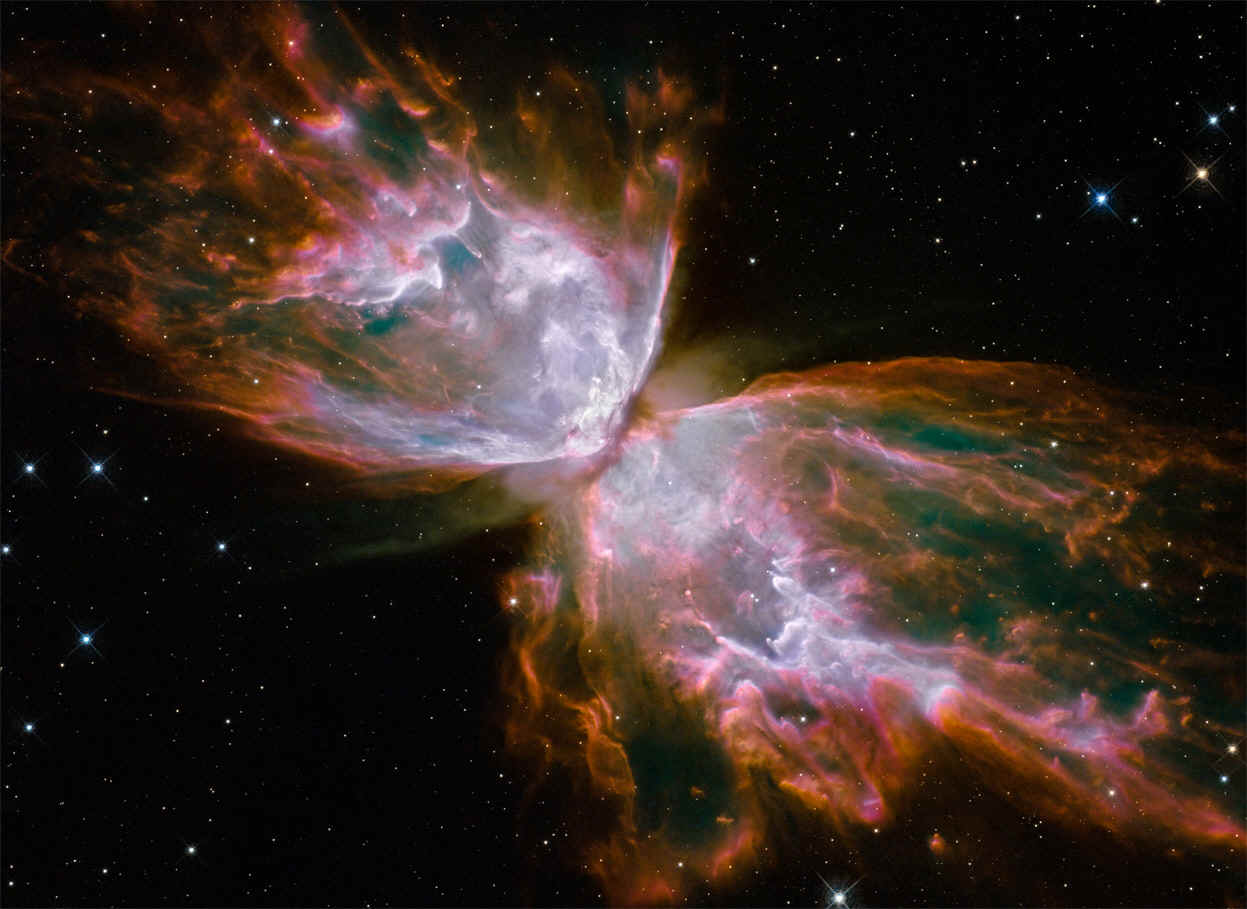
6. The Butterfly Nebula Nebula, NGC 6302, is one of the brightest and most extreme planetary nebulae known. What resemble dainty wings are actually roiling cauldrons of gas heated to more than 36,000 degrees Fahrenheit. The gas is tearing across space at more than 600,000 miles an hour. A dying star that was once about five times the mass of the Sun is at the center of this fury. It has ejected its envelope of gases and is now unleashing a stream of ultraviolet radiation that is making the cast-off material glow. NGC 6302 lies within our Milky Way galaxy, roughly 3,800 light-years away in the constellation Scorpius. The glowing gas is the star's outer layers, expelled over about 2,200 years. The "butterfly" stretches for more than two light-years, which is about half the distance from the Sun to the nearest star, Alpha Centauri. More info here.
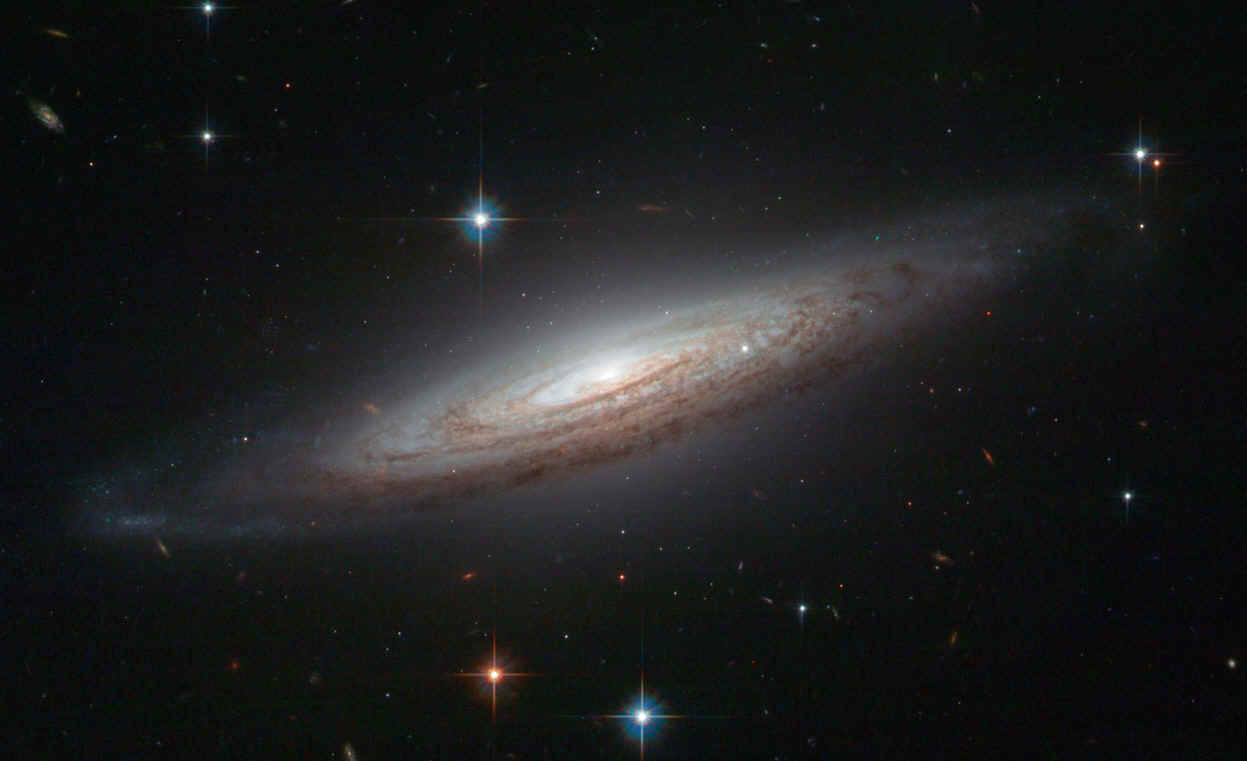
7. Fine detail and exceptionally perfect spiral structure are apparent in this image of galaxy NGC 634. This spiral galaxy was discovered back in the nineteenth century by French astronomer �douard Jean-Marie Stephan, but in 2008 it became a prime target for observations thanks to the violent demise of a white dwarf star. The type Ia supernova known as SN2008a was spotted in the galaxy and briefly rivalled the brilliance of its entire host galaxy but, despite the energy of the explosion, it can no longer be seen this Hubble image, which was taken around a year and a half later. Other, far more distant galaxies can be seen in the background as well in this image, which has an exposure time of nearly 3 hours. NGC 634 lies some 250 million light years away. More info here.
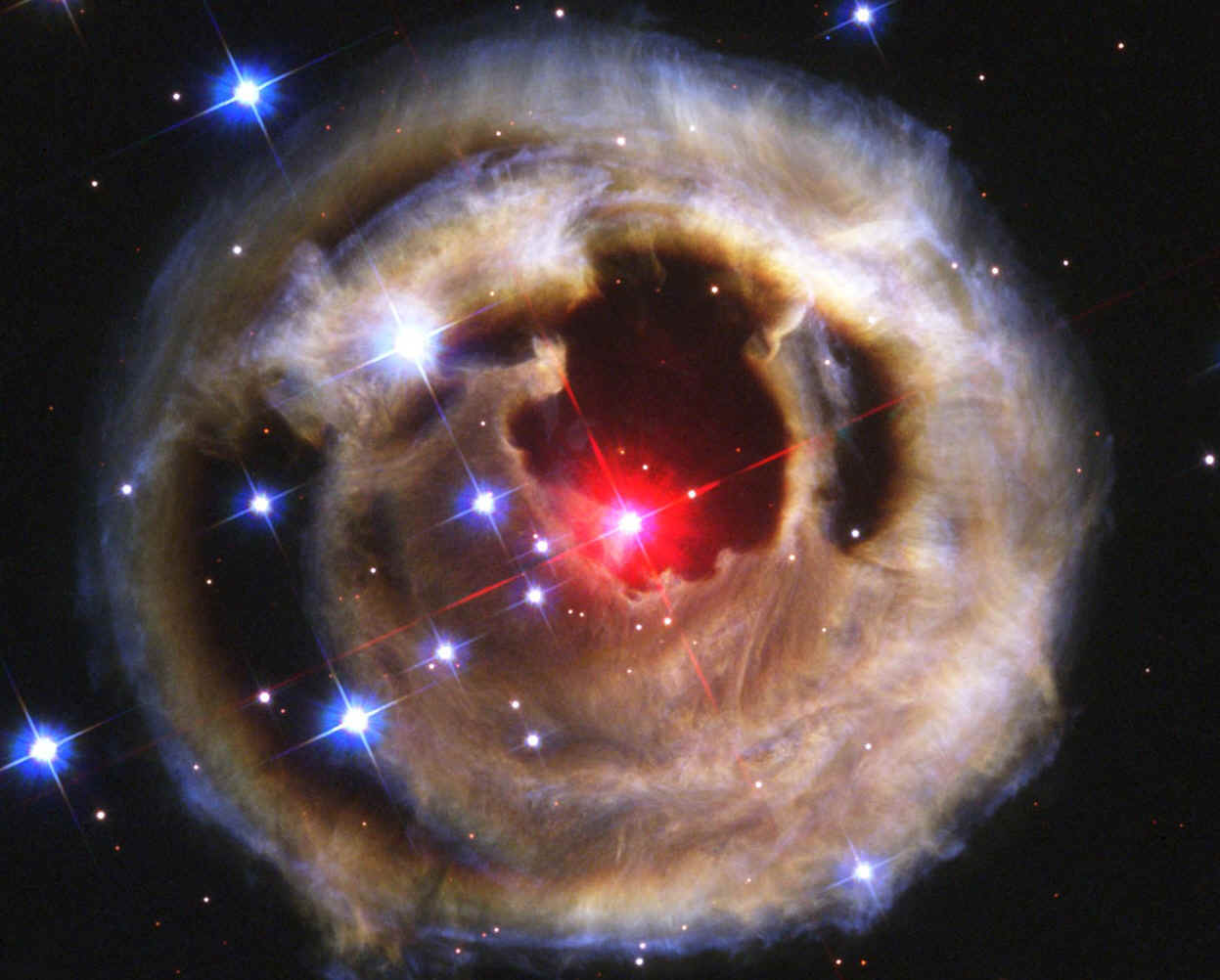
8. In January 2002, a dull star in an obscure constellation suddenly became 600,000 times more luminous than our Sun, temporarily making it the brightest star in our Milky Way galaxy. The burst of light from the bizarre star spread into space, reflecting off of surrounding shells of dust to reveal a spectacular set of images. The star, called V838 Monocerotis, has long since faded back to obscurity. But observations by NASA's Hubble Space Telescope of a phenomenon called a "light echo" around the star uncovered remarkable new features. These details provided astronomers with a CAT-scan-like probe of the three-dimensional structure of shells of dust surrounding an aging star. More info here.
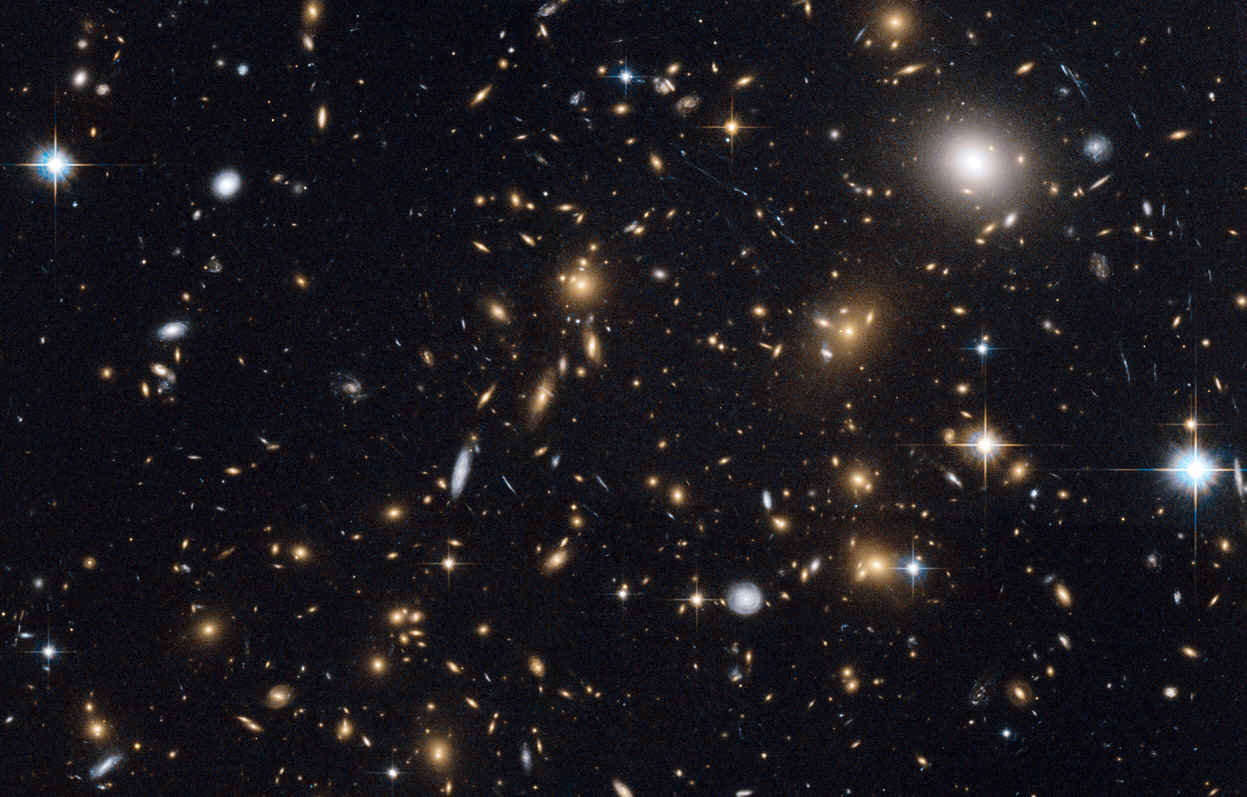
9. At first glance, the scatter of pale dots on this NASA/ESA Hubble Space Telescope image might look like a snowstorm in the night sky. But almost every one of these delicate snowflakes is a distant galaxy in the cluster MACS J0717.5+3745 and each is home to billions of stars. This apparently placid scene also hides a storm of epic scale. This picture shows a region where three galaxy clusters are merging and releasing enormous amounts of energy in the form of X-rays. These distant objects are around 5.4 billion light-years from Earth, and were imaged during the Massive Cluster Survey, a project to study distant clusters of galaxies using Hubble. The amount of mass in this sea of galaxies is huge, and is great enough to visibly bend the fabric of spacetime. The strange distortion in the shapes of some of the galaxies in this picture, which appear stretched and bent as if they were looked at through a glass bottle, is a result of gravitational lensing, where the gravitational fields around massive objects bend light around them. Predicted by Einstein in his famous general theory of relativity, gravity's ability to distort light was first demonstrated in 1919 in a well-known experiment carried out by Sir Arthur Eddington, who led an expedition to the island of Principe, off the coast of Africa, to measure the apparent shift of a star when observed close to the edge of the Sun's disc during a solar eclipse. More info here.
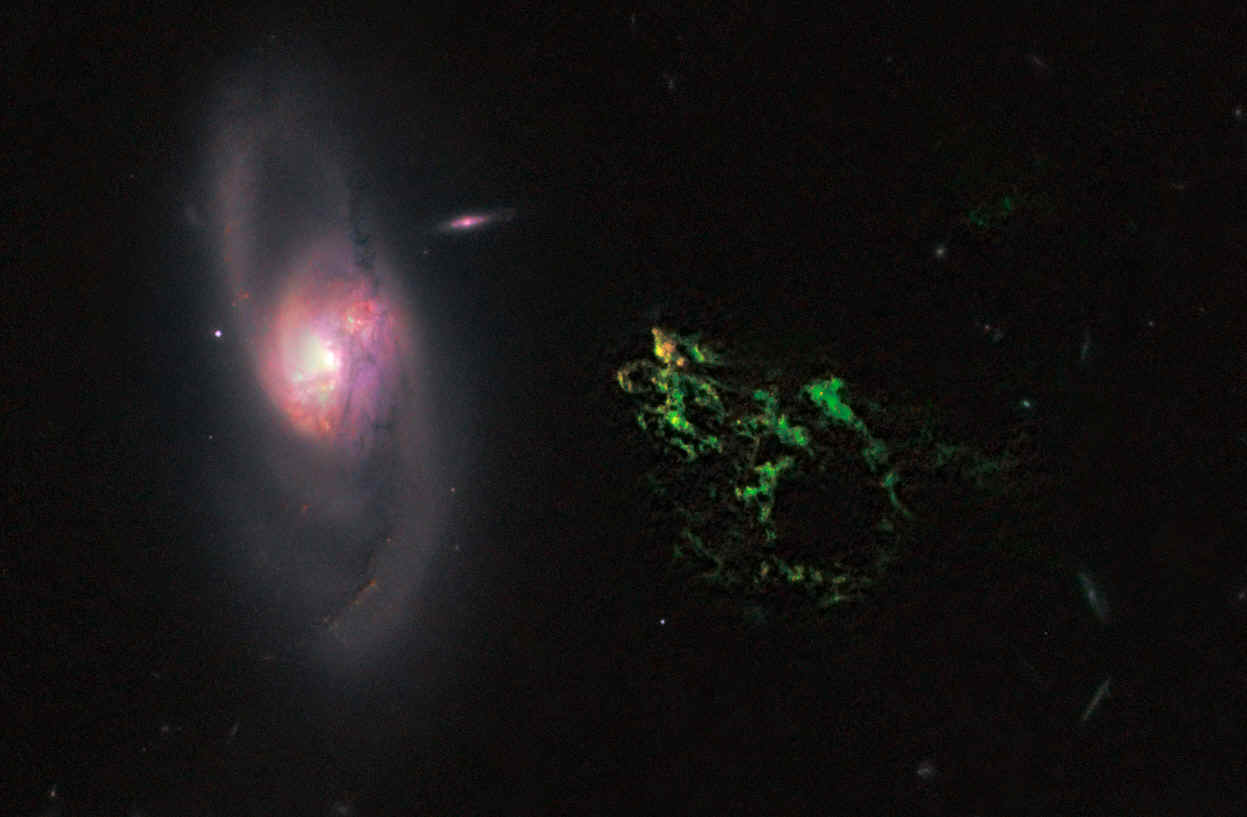
10. An unusual, ghostly green blob of gas appears to float near a normal-looking spiral galaxy. The bizarre object, dubbed Hanny's Voorwerp (Hanny's Object in Dutch), is the only visible part of a 300,000-light-year-long streamer of gas stretching around the galaxy, called IC 2497. The greenish Voorwerp is visible because a searchlight beam of light from the galaxy's core illuminated it. This beam came from a quasar, a bright, energetic object that is powered by a black hole. The quasar may have turned off about 200,000 years ago. This Hubble view uncovers a pocket of star clusters, the yellowish-orange area at the tip of Hanny's Voorwerp. The star clusters are confined to an area that is a few thousand light-years wide. The youngest stars are a couple of million years old. The Voorwerp is the size of our Milky Way galaxy, and its bright green color is from glowing oxygen. Hubble also shows that gas flowing from IC 2497 may have instigated the star birth by compressing the gas in Hanny's Voorwerp. The galaxy is located about 650 million light-years from Earth. What appears to be a gaping hole in Hanny's Voorwerp actually may be a shadow cast by an object in the quasar's light path. The feature gives the illusion of a hole about 20,000 light-years wide. Hubble reveals sharp edges but no other changes in the gas around the apparent opening, suggesting that an object close to the quasar may have blocked some of the light and projected a shadow on the Voorwerp. This phenomenon is similar to a fly on a movie projector lens casting a shadow on a movie screen. More info here.
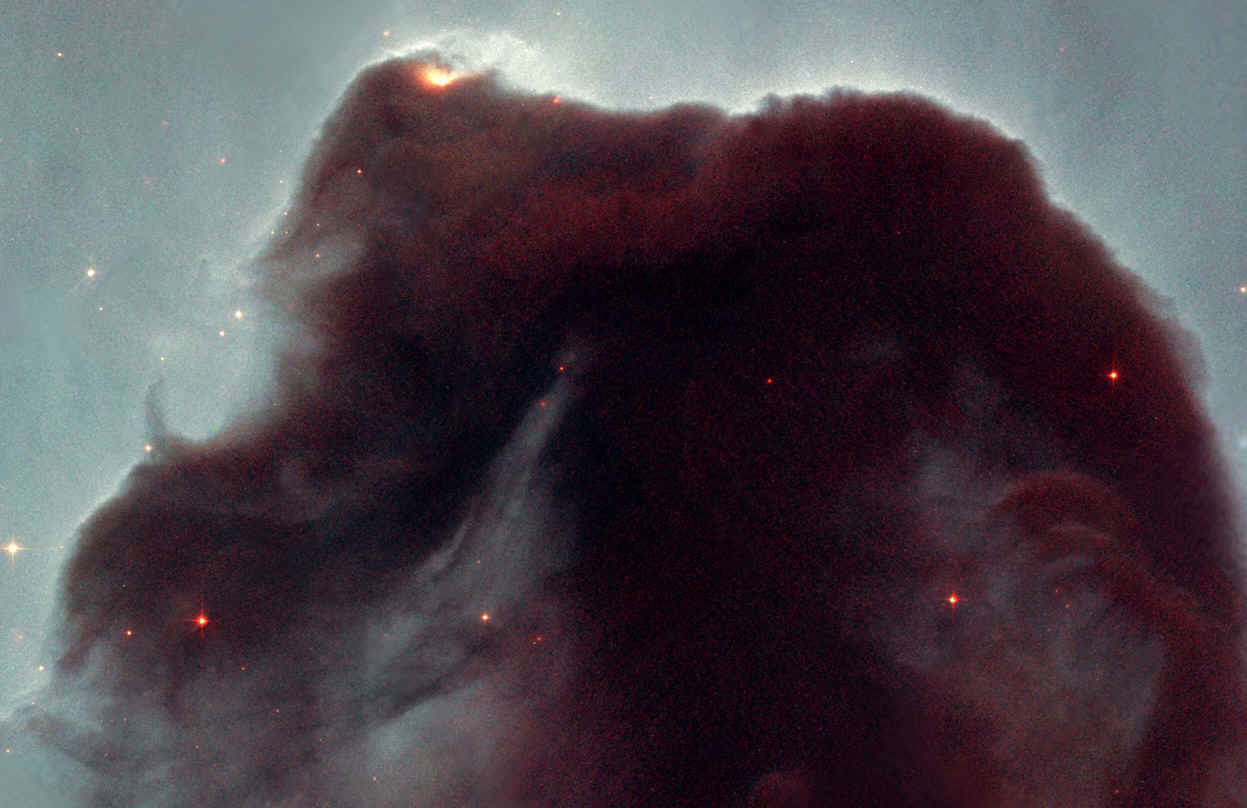
11. The Horsehead Nebula, also known as Barnard 33, is a cold, dark cloud of gas and dust, silhouetted against the bright nebula, IC 434. The bright area at the top left edge is a young star still embedded in its nursery of gas and dust. But radiation from this hot star is eroding the stellar nursery. The top of the nebula also is being sculpted by radiation from a massive star located out of Hubble's field of view. Only by chance does the nebula roughly resemble the head of a horse. Its unusual shape was first discovered on a photographic plate in the late 1800s. More info here.
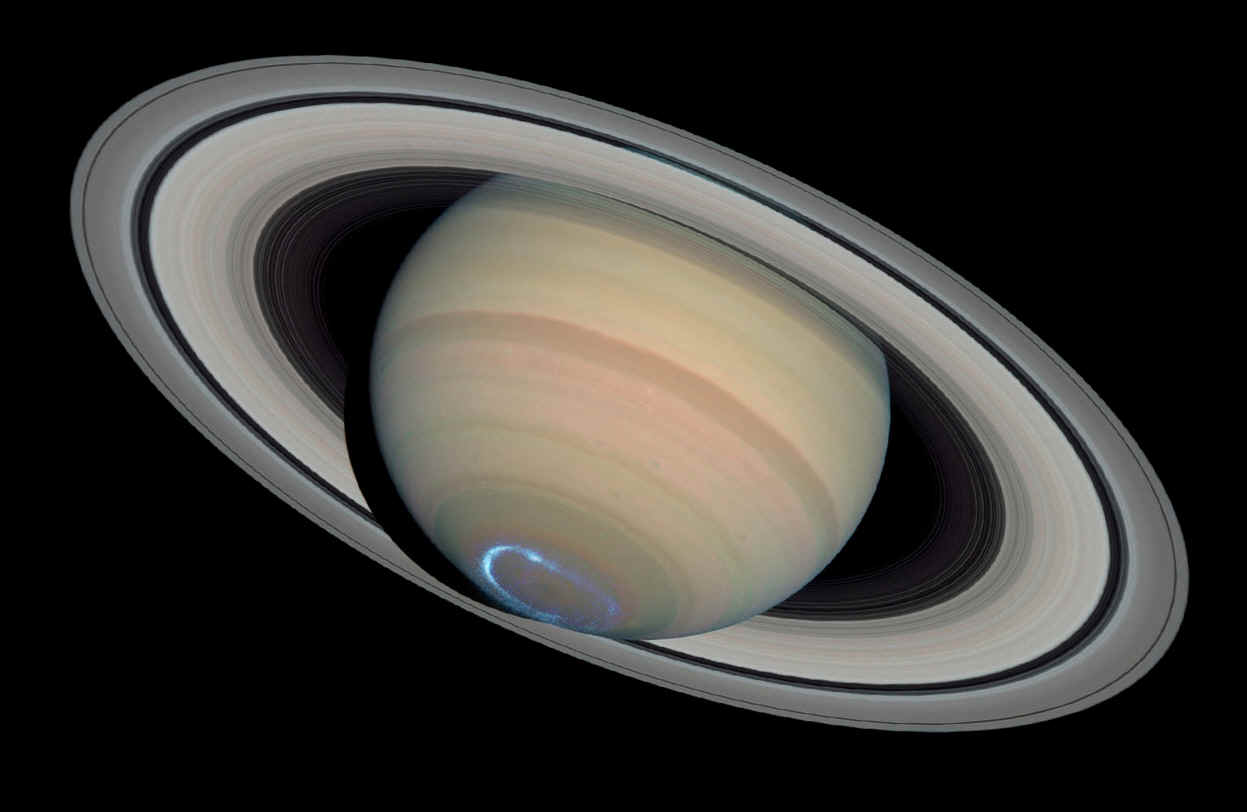
12. The dancing light of the auroras on Saturn. Seen from space, an aurora appears as a ring of glowing gases circling a planet's polar region. Auroral displays are initiated when charged particles in space collide with a planet's magnetic field. The charged particles are accelerated to high energies and stream into the upper atmosphere. Collisions with the gases in the planet's atmosphere produce flashes of glowing energy in the form of visible, ultraviolet, and infrared light. Astronomers combined ultraviolet images of Saturn's southern polar region with visible-light images of the planet and its rings from both Hubble and the Cassini spacecraft to make this picture. The auroral display appears blue because of the glow of ultraviolet light. In reality, the aurora would appear red to an observer at Saturn because of the presence of glowing hydrogen in the atmosphere. This image was taken in January of 2004. More info here.
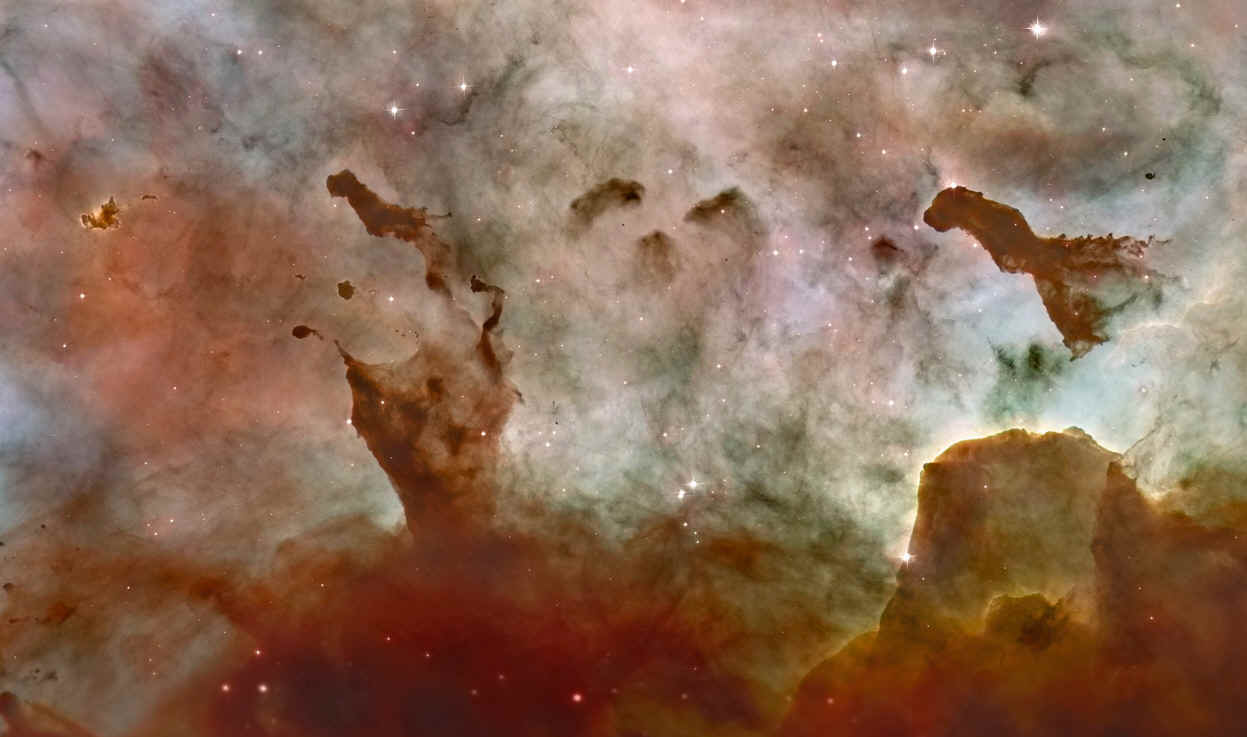
13. Dark clouds float in the fantasy-like landscape of the Carina Nebula, sculpted by the action of outflowing winds and scorching ultraviolet radiation from the monster stars that inhabit this inferno. In the process, these stars are shredding the surrounding material that is the last vestige of the giant cloud from which the stars were born. The immense nebula is an estimated 7,500 light-years away in the southern constellation Carina the Keel (of the old southern constellation Argo Navis, the ship of Jason and the Argonauts, from Greek mythology). This detail is from a mosaic of the Carina Nebula assembled from 48 frames taken with Hubble Space Telescope's Advanced Camera for Surveys. The Hubble images were taken in the light of ionized hydrogen. Red corresponds to sulfur, green to hydrogen, and blue to oxygen emission. More info here.
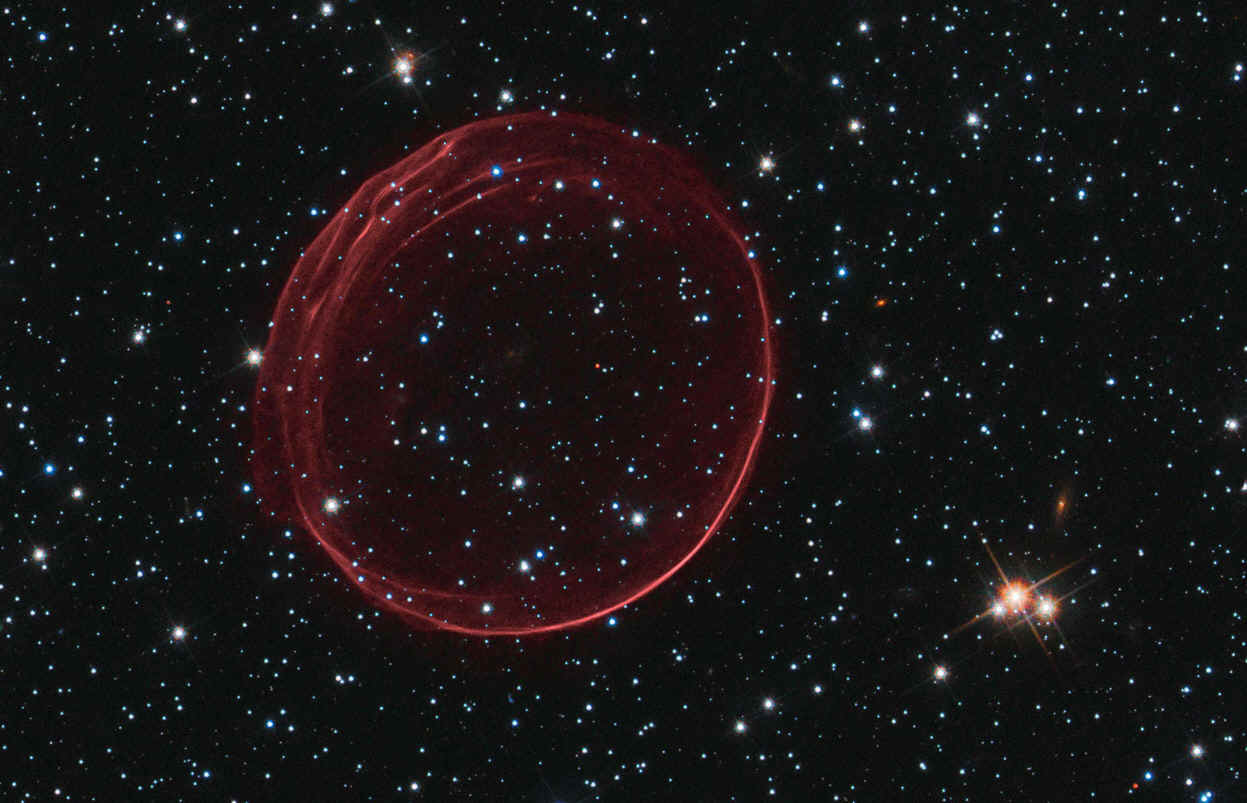
14. A delicate sphere of gas floats serenely in the depths of space. The pristine shell, or bubble, is the result of gas that is being shocked by the expanding blast wave from a supernova. Called SNR 0509-67.5 (or SNR 0509 for short), the bubble is the visible remnant of a powerful stellar explosion in the Large Magellanic Cloud (LMC), a small galaxy about 160,000 light-years from Earth. Ripples in the shell's surface may be caused by either subtle variations in the density of the ambient interstellar gas, or possibly driven from the interior by pieces of the ejecta. The bubble-shaped shroud of gas is 23 light-years across and is expanding at more than 11 million miles per hour (5,000 kilometers per second). Astronomers have concluded that the explosion was one of an especially energetic and bright variety of supernovae. Known as Type Ia, such supernova events are thought to result from a white dwarf star in a binary system that robs its partner of material, takes on much more mass than it is able to handle, and eventually explodes. Hubble's Advanced Camera for Surveys observed the supernova remnant on Oct. 28, 2006, with a filter that isolates light from glowing hydrogen seen in the expanding shell. These observations were then combined with visible-light images of the surrounding star field that were imaged with Hubble's Wide Field Camera 3 on Nov. 4, 2010. With an age of about 400 years as seen from Earth, the supernova might have been visible to southern hemisphere observers around the year 1600. However, there are no known records of a "new star" in the direction of the LMC near that time. A more recent supernova in the LMC, SN 1987A, did catch the eye of Earth viewers and continues to be studied with ground- and space-based telescopes, including Hubble. More info here.
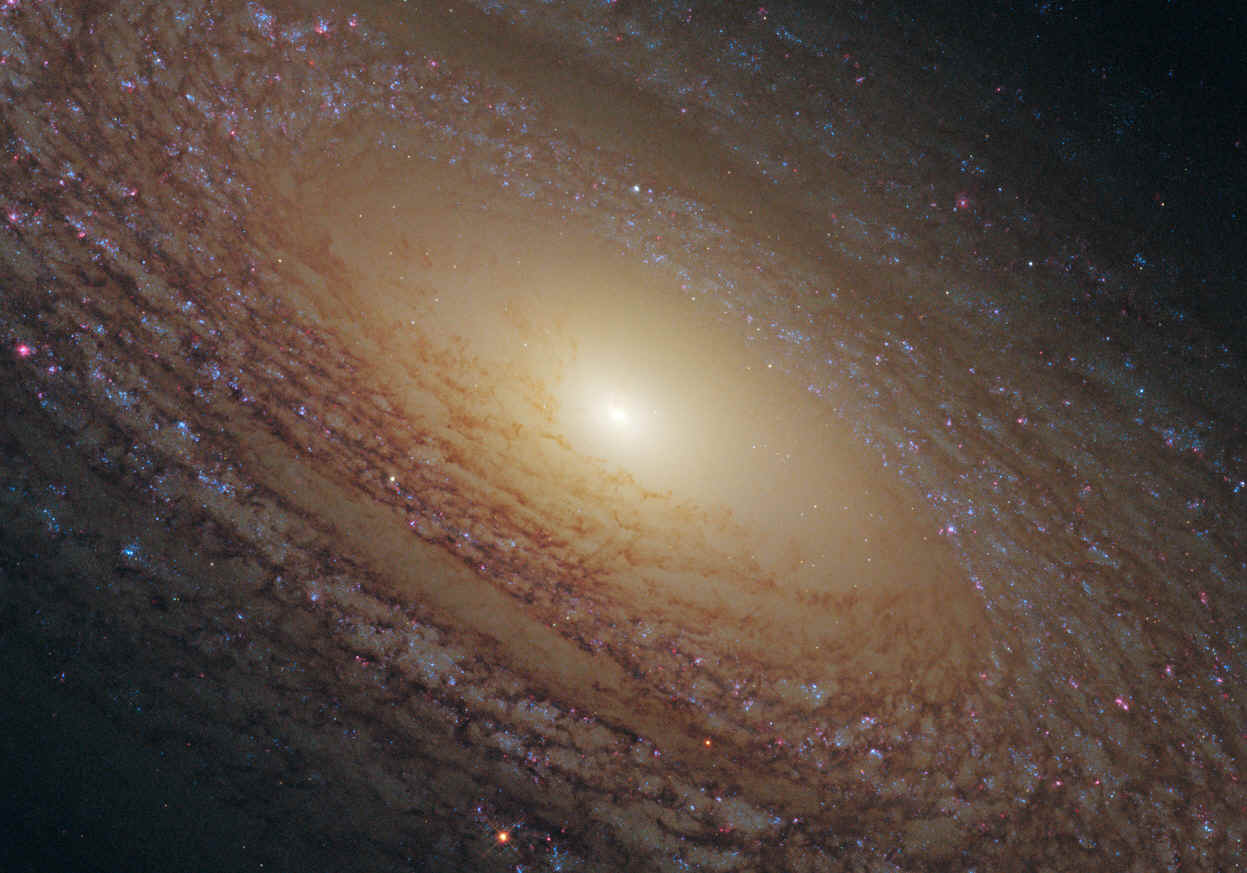
15. A close view of spiral galaxy NGC 2841. A bright cusp of starlight marks the galaxy's center. Spiraling outward are dust lanes that are silhouetted against the population of whitish middle-aged stars. Much younger blue stars trace the spiral arms. Notably missing are pinkish emission nebulae indicative of new star birth. It is likely that the radiation and supersonic winds from fiery, super-hot, young blue stars cleared out the remaining gas (which glows pink), and hence shut down further star formation in the regions in which they were born. NGC 2841 currently has a relatively low star formation rate compared to other spirals that are ablaze with emission nebulae. NGC 2841 lies 46 million light-years away in the constellation of Ursa Major (The Great Bear). This image was taken in 2010 through four different filters on Hubble's Wide Field Camera 3. More info here.
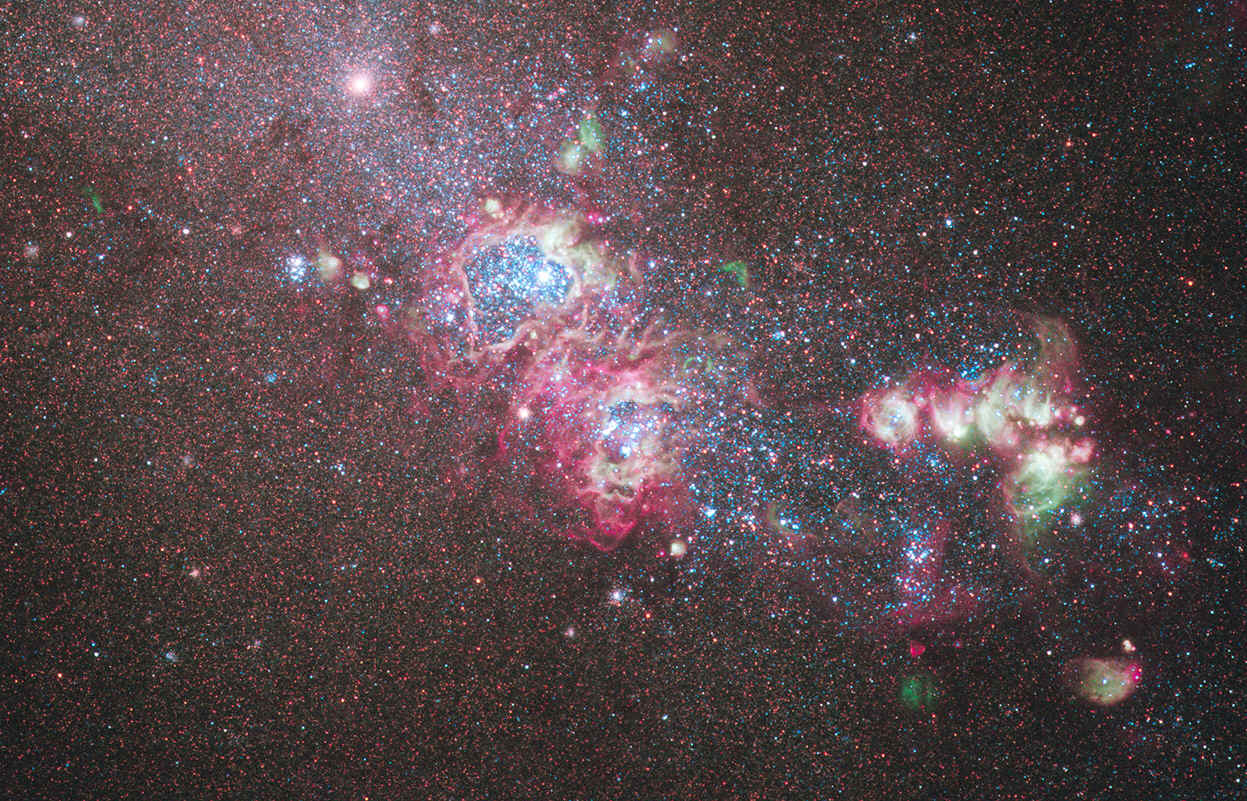
16. This is a full-field image of the nearby dwarf galaxy NGC 4214. Episodes of star formation are revealed as the galaxy continues to form clusters of new stars from its interstellar gas and dust. This image reveals a sequence of steps in the formation and evolution of stars and star clusters, evident in the glowing gas surrounding bright stellar clusters. The young clusters of new stars appear within bright clumps of glowing gas. Each cloud glows because of the strong ultraviolet light emitted from the embedded young stars, which have formed within them due to the gravitational collapse of the gas. These hot stars also eject fast "stellar winds" moving at millions of miles per hour (thousands of kilometers per second), which plow into the surrounding gas. The radiation and wind from the young stars literally blow bubbles in the gas. The main object near the center of the galaxy is a cluster of hundreds of massive blue stars, each more than 10,000 times brighter than our Sun. A vast heart-shaped bubble, inflated by the combined stellar winds and radiation pressure, surrounds the cluster. The bubble will increase in size as the most massive stars in the center reach the ends of their lives and explode as supernovae. This dwarf galaxy resides 10 million light-years away in the constellation Canes Venatici. More info here.
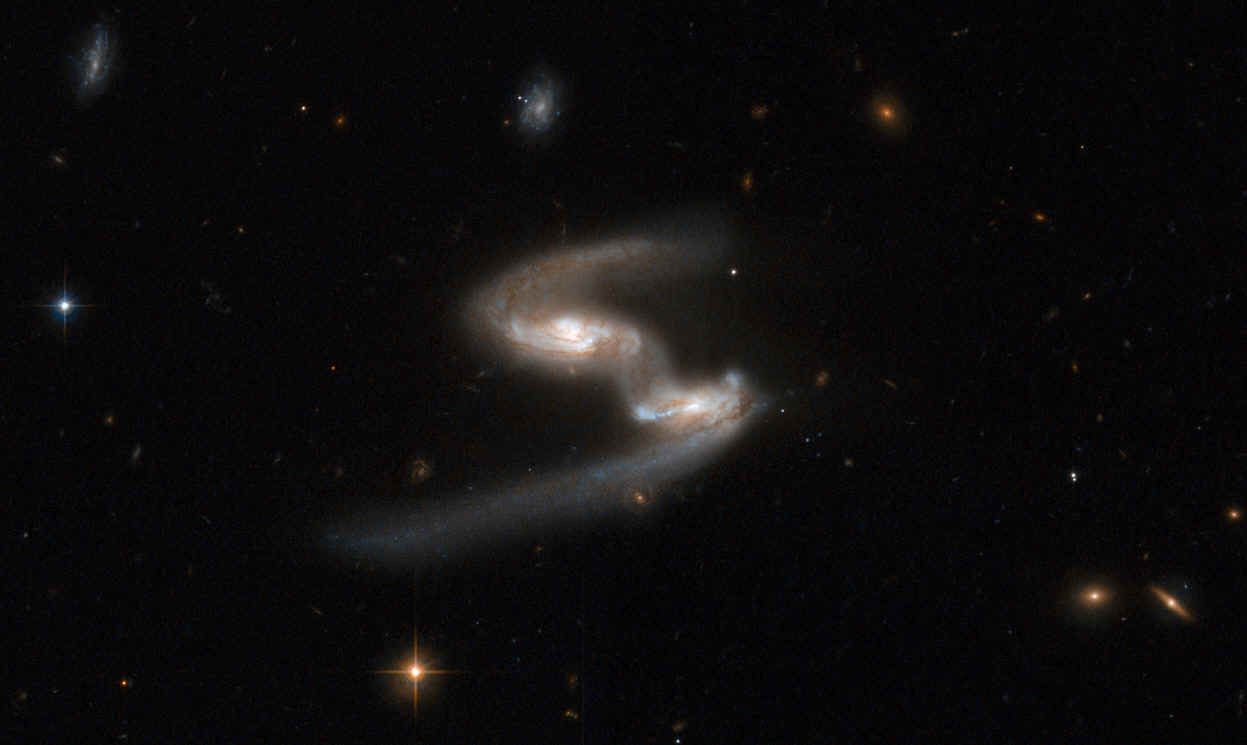
17. This image of ESO 77-14 is a stunning snapshot of a celestial dance performed by a pair of similar sized galaxies. Two clear signatures of the gravitational tug of war between the galaxies are the bridge of material that connects them and the disruption of their main bodies. The galaxy on the right has a long, bluish arm while its companion has a shorter, redder arm. This interacting pair is in the constellation of Indus, the Indian, some 550 million light-years away from Earth. The dust lanes between the two galaxy centers show the extent of the distortion to the originally flat disks that have been pulled into three-dimensional shapes. More info here.
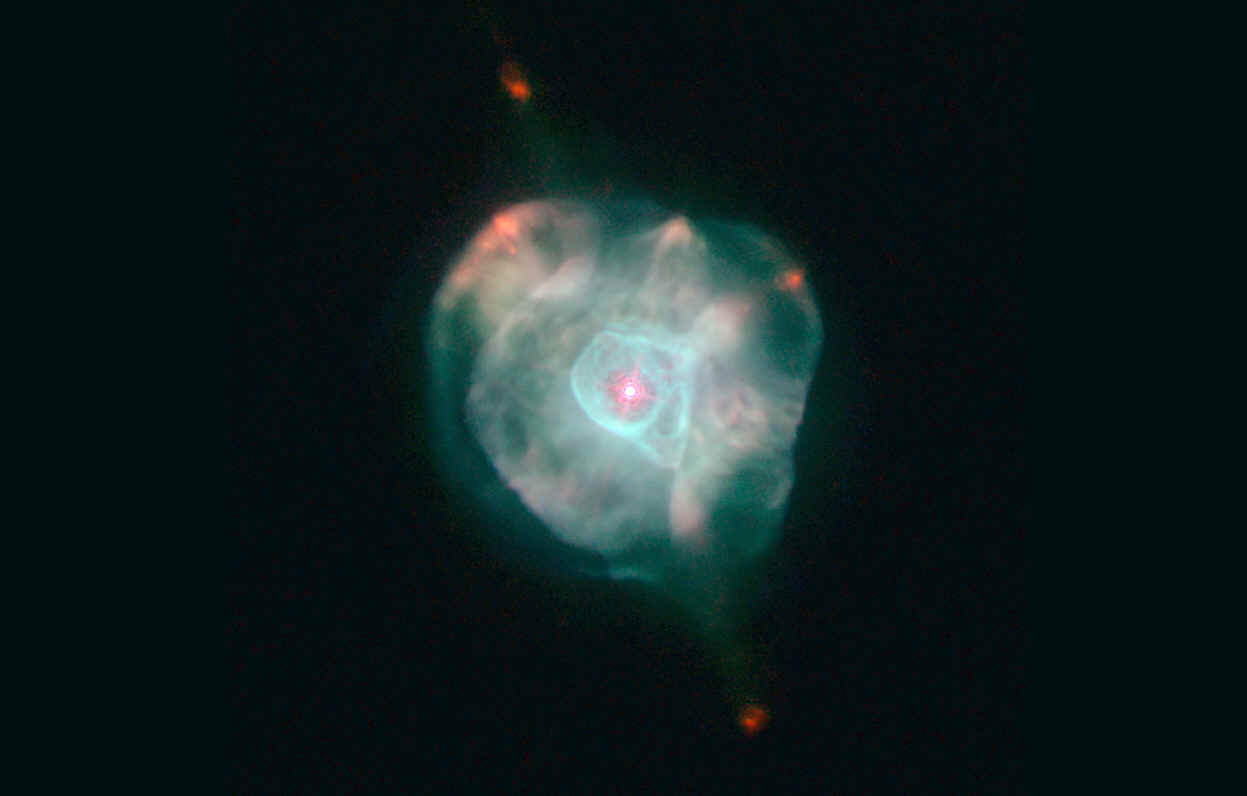
18. This gaseous cloud named IC 4593 is a planetary nebula. Planetary nebulae are created when stars in the last stages of life cast off their outer layers of material into space. Ultraviolet light from the remnant star makes the material glow. Planetary nebulae last for only 10,000 years, a fleeting episode in the 10-billion-year lifespan of Sun-like stars. Over thousands of years, the clouds of gas expand away and the nebulae become larger. Energetic ultraviolet light from the star penetrates more deeply into the gas, causing the hydrogen and oxygen to glow more prominently. In older nebulae, such as IC 4593, hydrogen and oxygen appear more extended in these regions, and red knots of nitrogen are still visible. IC 4593 lies some about 7,000 light-years from Earth, in the northern constellation Hercules. More info here.
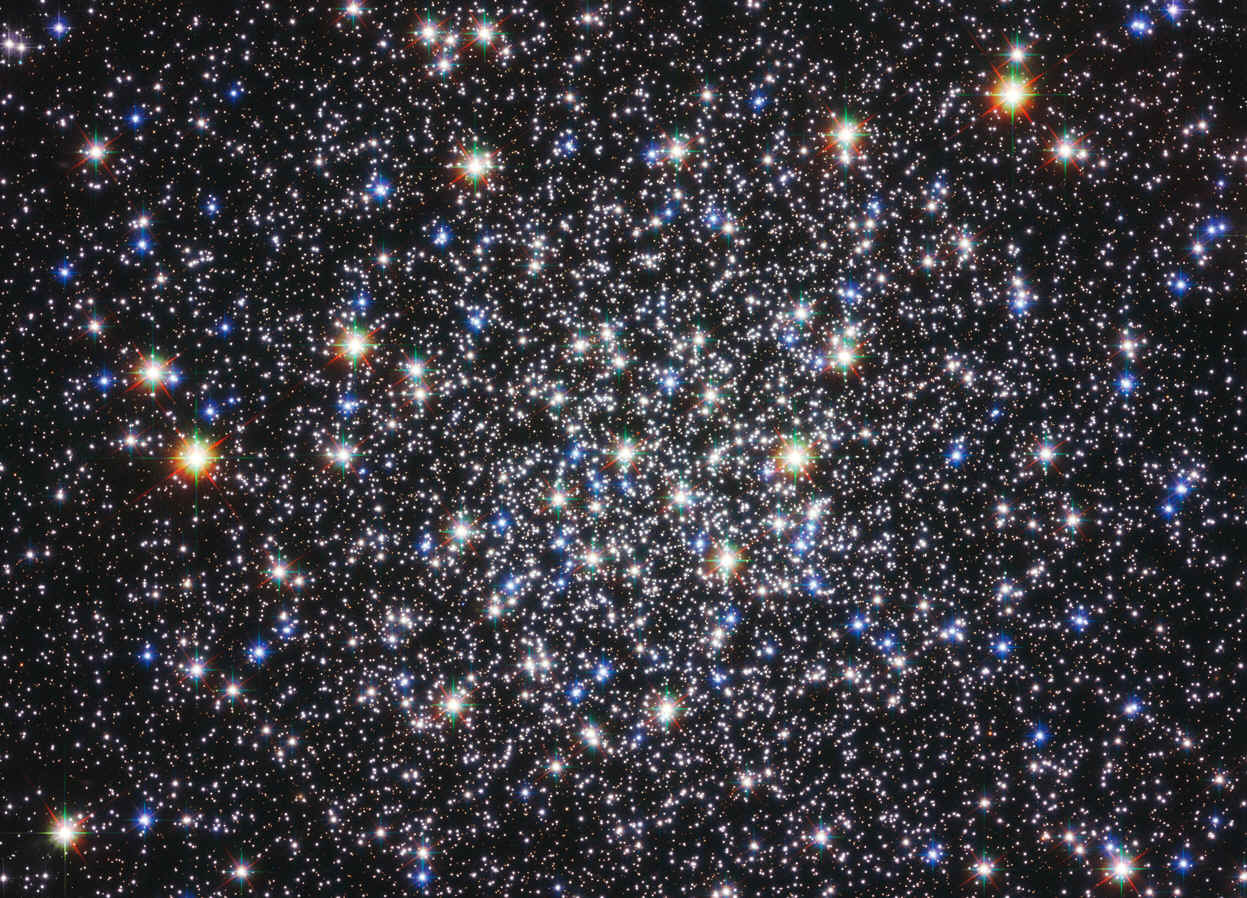
19. The high concentration of stars within globular clusters, like Messier 12, shown here, makes them beautiful photographic targets. But the cramped living quarters in these clusters also makes them home to exotic binary star systems where two stars are locked in tight orbits around each other and matter from one is gobbled up by its companion, releasing X-rays. It is thought that such X-ray binaries form from very close encounters between stars in crowded regions, such as globular clusters, and even though Messier 12 is fairly diffuse by globular cluster standards, such X-ray sources have been spotted there. Astronomers have also discovered that Messier 12 is home to far fewer low-mass stars than was previously expected. In a recent study, astronomers used the European Southern Observatory's Very Large Telescope at Cerro Paranal, Chile, to measure the brightness and colours of more than 16,000 of the cluster's 200,000 stars. They speculate that nearly one million low-mass stars have been ripped away from Messier 12 as the globular has passed through the densest regions of the Milky Way during its orbit around the galactic center. It seems that the serenity of this view of Messier 12 is misleading and the object has had a violent and disturbed past. Messier 12 lies about 23 000 light-years away in the constellation of Ophiuchus (The Serpent Bearer). More info here.
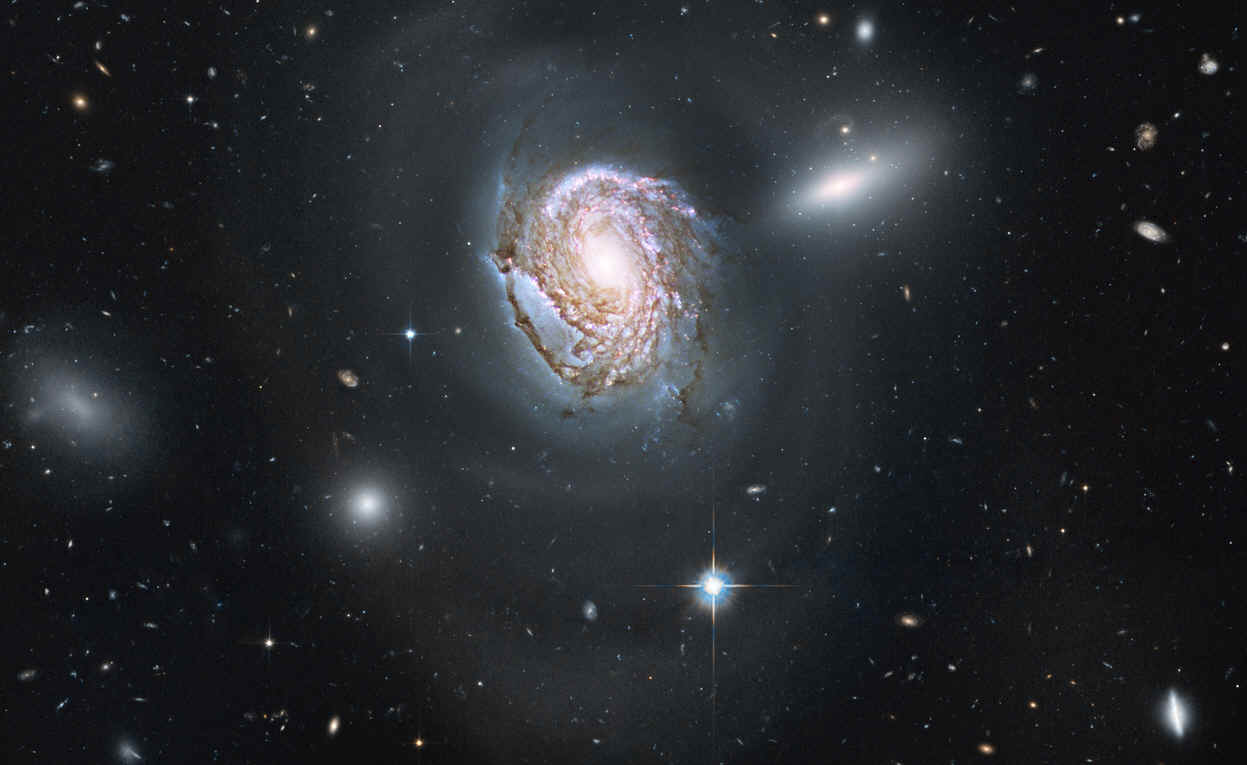
20. A long-exposure image shows a majestic face-on spiral galaxy located deep within the Coma Cluster of galaxies, which lies 320 million light-years away in the northern constellation Coma Berenices. The galaxy, known as NGC 4911, contains rich lanes of dust and gas near its center. These are silhouetted against glowing newborn star clusters and iridescent pink clouds of hydrogen, the existence of which indicates ongoing star formation. Hubble has also captured the outer spiral arms of NGC 4911, along with thousands of other galaxies of varying sizes. The high resolution of Hubble's cameras, paired with considerably long exposures, made it possible to observe these faint details. NGC 4911 and other spirals near the center of the cluster are being transformed by the gravitational tug of their neighbors. In the case of NGC 4911, wispy arcs of the galaxy's outer spiral arms are being pulled and distorted by forces from a companion galaxy (NGC 4911A), to the upper right. This natural-color Hubble image, which combines data obtained in 2006, 2007, and 2009 from the Wide Field Planetary Camera 2 and the Advanced Camera for Surveys, required 28 hours of exposure time. More info here.
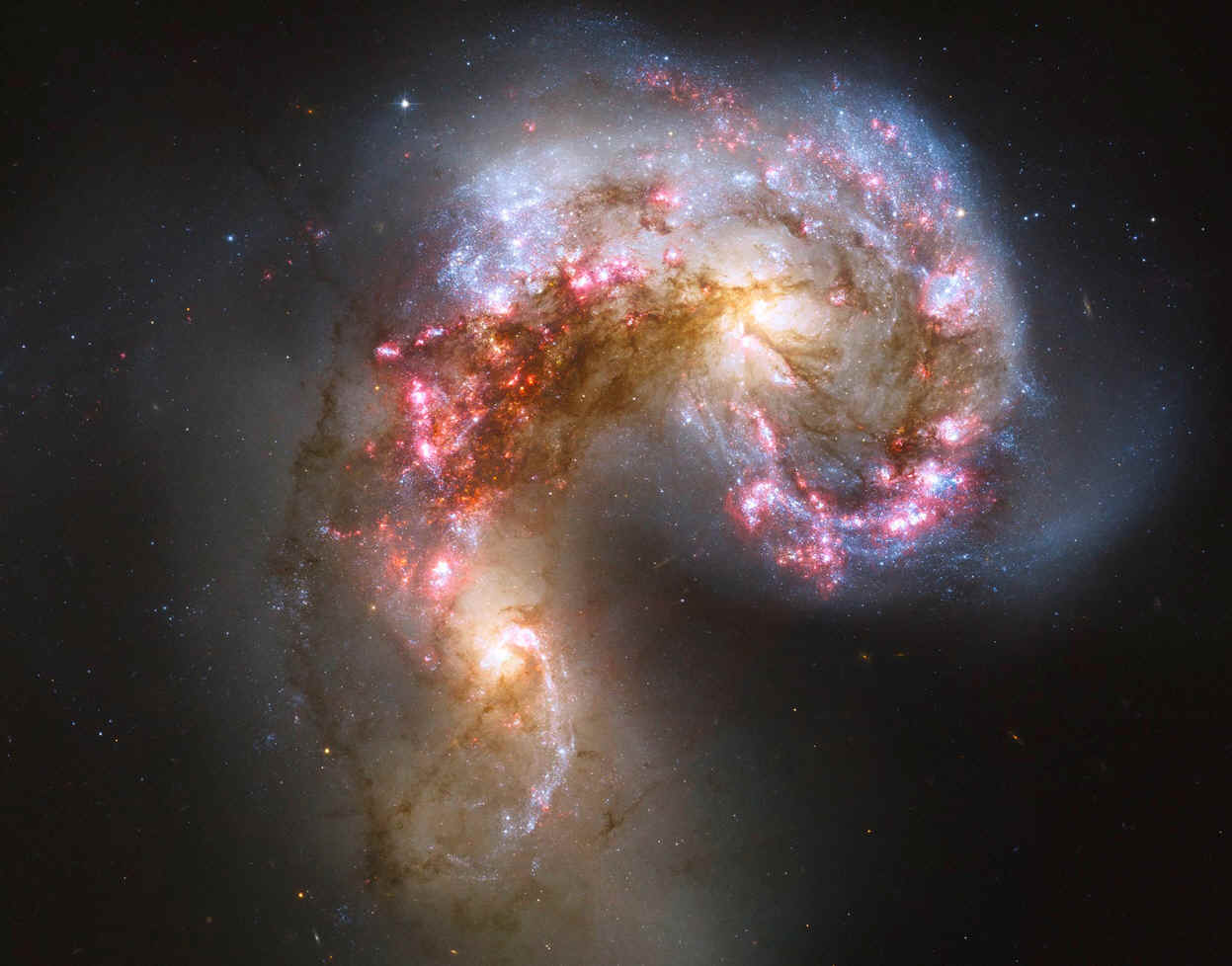
21. The Antennae galaxies, a pair of merging spiral galaxies. During the course of the collision, billions of stars will be formed. The brightest and most compact of these star birth regions are called super star clusters. The two galaxies started to interact a few hundred million years ago, making the Antennae galaxies one of the nearest and youngest examples of a pair of colliding galaxies. Nearly half of the faint objects in the Antennae image are young clusters containing tens of thousands of stars. The orange blobs to the left and right of image center are the two cores of the original galaxies and consist mainly of old stars criss-crossed by filaments of dust, which appears brown in the image. The two galaxies are dotted with brilliant blue star-forming regions surrounded by glowing hydrogen gas, appearing in the image in pink. The Antennae galaxies take their name from the long antenna-like "arms" extending far out from the nuclei of the two galaxies, best seen by ground-based telescopes. More info here.
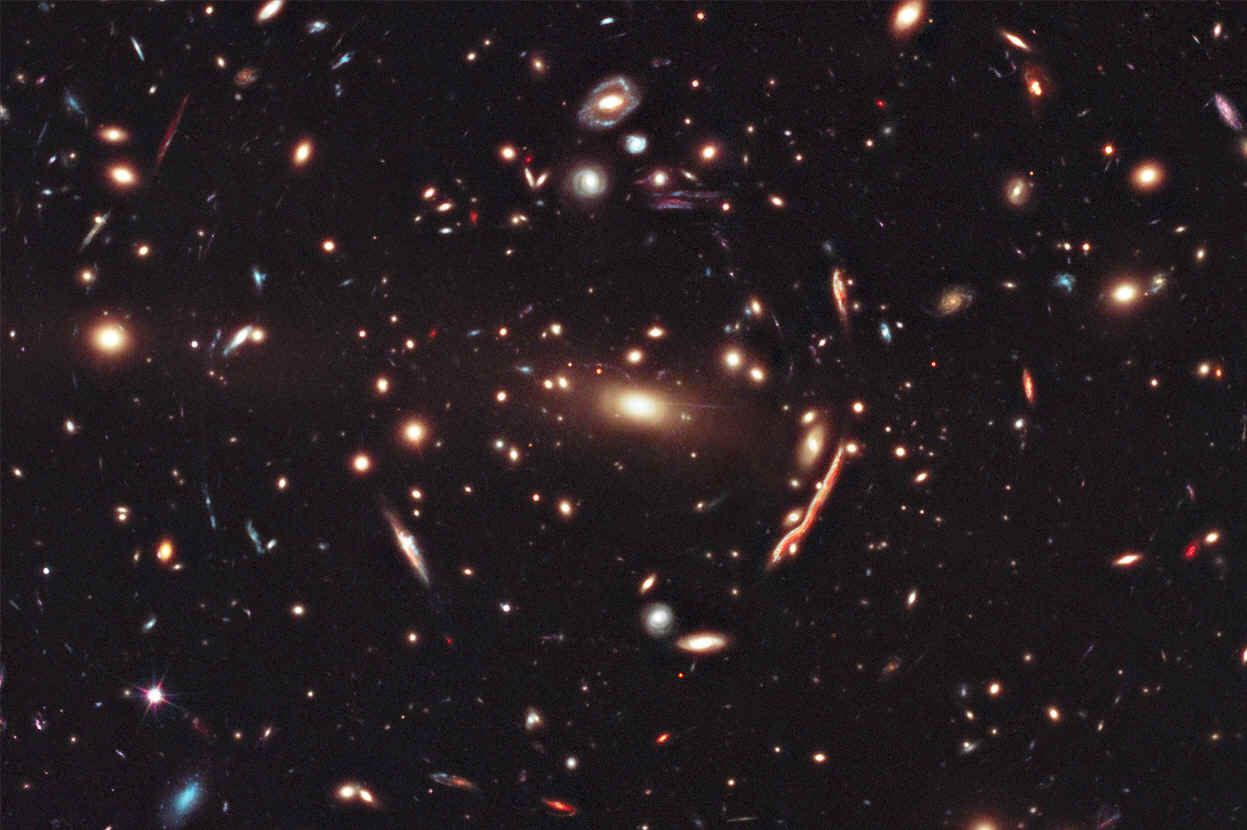
22. Four and a half billion light-years away in the constellation Virgo, scores of galaxies in a cluster known as MACS 1206 have been drawn together by their mutual gravitational pull. Gravity from the cluster's immense mass bends the space around it, causing the images of more distant galaxies directly behind the cluster (that are within our line of sight) to be warped and cast into arc-like smears of light. The orange streak to the right of the image center is one such example of an optically distorted galaxy that resides millions of light-years behind MACS 1206. The circular pattern of smaller galaxy pieces is more evidence of gravitational lensing. The central object in the cluster is a giant elliptical galaxy plump with billions of old, reddish suns, surrounded by a thinner halo of stars. Disk-shaped spiral galaxies appear, both edge- and face-on, showing a defined structure of arms encircling their central bulges. The bluer galaxies have stars actively forming within them and, consequently, host groups of young blue stars that contribute to their overall hue. In contrast, red galaxies - especially those elliptical galaxies like the center one - are more stable in their behavior, with very few little recent star formation. More info here.
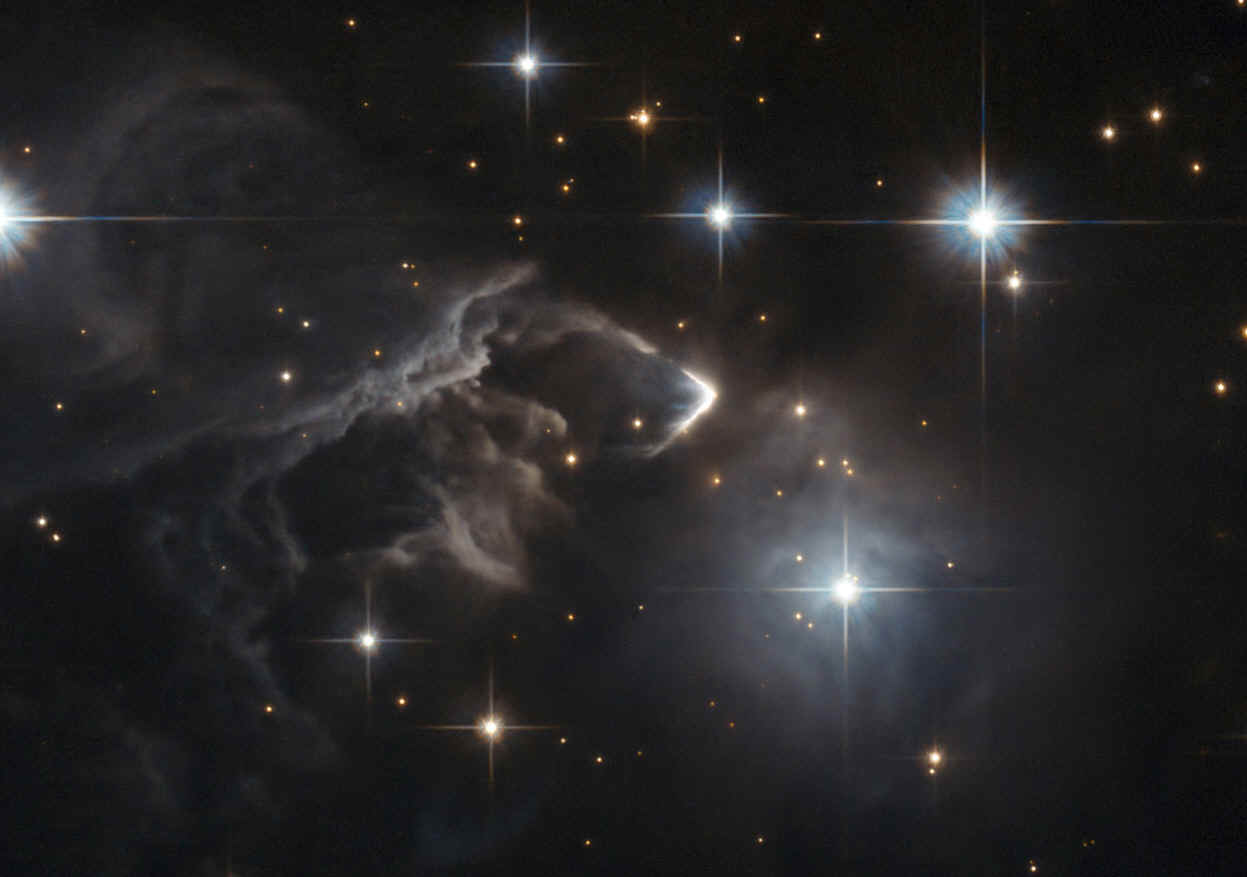
23. The little-known nebula IRAS 05437+2502 billows out among the bright stars and dark dust clouds that surround it in this striking image. It is located in the constellation of Taurus (the Bull), close to the central plane of our Milky Way galaxy. Unlike many of Hubble's targets, this object has not been studied in detail and its exact nature is unclear. At first glance it appears to be a small, rather isolated, region of star formation and one might assume that the effects of fierce ultraviolet radiation from bright young stars probably were the cause of the eye-catching shapes of the gas. However, the bright boomerang-shaped feature may tell a more dramatic tale. The interaction of a high velocity young star and the cloud of gas and dust may have created this unusually sharp-edged bright arc. Such a reckless star would have been ejected from the distant young cluster where it was born and would travel at 200,000 km/hour or more through the nebula. More info here.
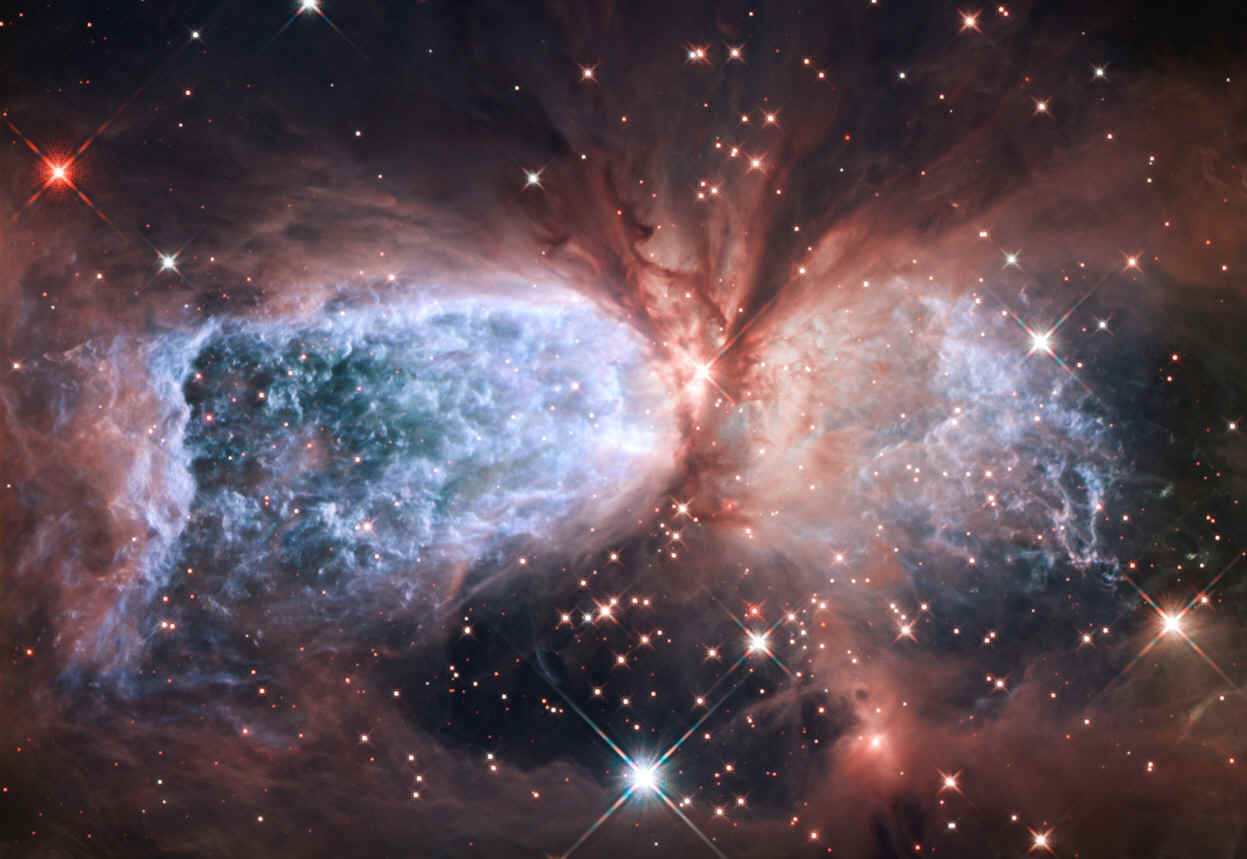
24. The outstretched "wings" of the this bipolar star-forming region called Sharpless 2-106 record the contrasting imprint of heat and motion against the backdrop of a colder medium. Sharpless 2-106, Sh2-106 or S106 for short, lies nearly 2,000 light-years from us. The nebula measures several light-years in length. It appears in a relatively isolated region of the Milky Way galaxy. A massive, young star, IRS 4 (Infrared Source 4), is responsible for the furious activity we see in the nebula. Twin lobes of super-hot gas, glowing blue in this image, stretch outward from the central star. A ring of dust and gas orbiting the star acts like a belt, cinching the expanding nebula into an "hourglass" shape. Hubble's sharp resolution reveals ripples and ridges in the gas as it interacts with the cooler interstellar medium. Dusky red veins surround the blue emission from the nebula. The faint light emanating from the central star reflects off of tiny dust particles. This illuminates the environment around the star, showing darker filaments of dust winding beneath the blue lobes. More info here.
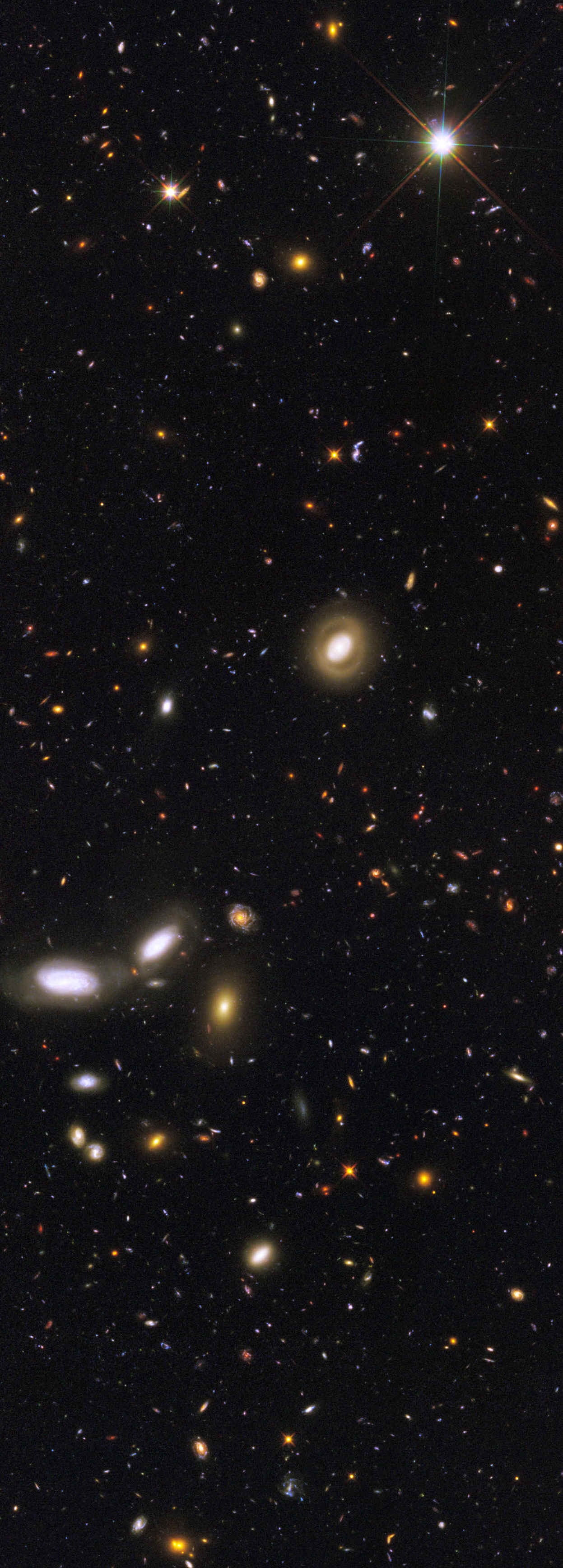
25. More than 12 billion years of cosmic history are shown in this unprecedented, panoramic, full-color view of thousands of galaxies in various stages of assembly. The view covers a portion of the southern field of a large galaxy census called the Great Observatories Origins Deep Survey (GOODS), a deep-sky study by several observatories to trace the formation and evolution of galaxies. The image shows a rich tapestry of thousands galaxies stretching back through most of the universe's history. The closest galaxies seen in the foreground emitted their observed light about a billion years ago. The farthest galaxies, a few of the very faint red specks, are seen as they appeared more than 13 billion years ago, or roughly 650 million years after the Big Bang. From top to bottom, this mosaic spans a tiny slice of space that is equal to 1/6 of the full moon, 5 arcminutes -- or, if you held a penny up to the sky at arms length, and looked at it edge-on, the thickness of the penny would nearly cover the whole vista. This Hubble image is one of several, including the Ultra Deep Field, which peer into seemingly empty space, leaving the camera shutter open for hours, and reveal that billions of galaxies made up of billions of stars fill our skies in every direction as far as we can possibly see, separated by almost unimaginable distance and time, yet still reachable, visible as an image of their long-ago selves. Take a good look at the image above, nearly every speck of color is a galaxy. Seeing that, and thinking of the recent explosion in discoveries of planets outside our own solar system (over 700 found to date), the unbelievably vast scale of possible worlds in the Universe becomes apparent - out there, all around us. Merry Christmas, thanks for spending some time with these images, and many thanks to all the scientific teams responsible. Here's hoping for even more amazing discoveries in 2012! - Alan More info here.